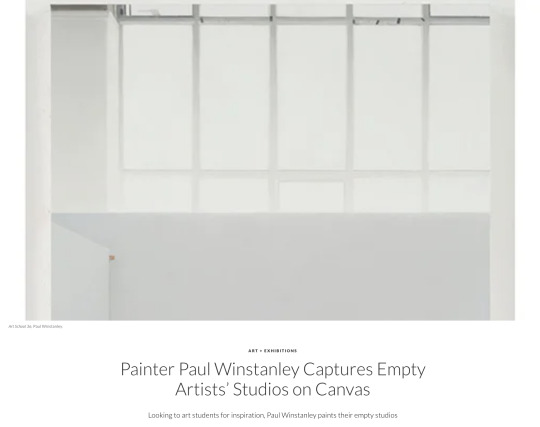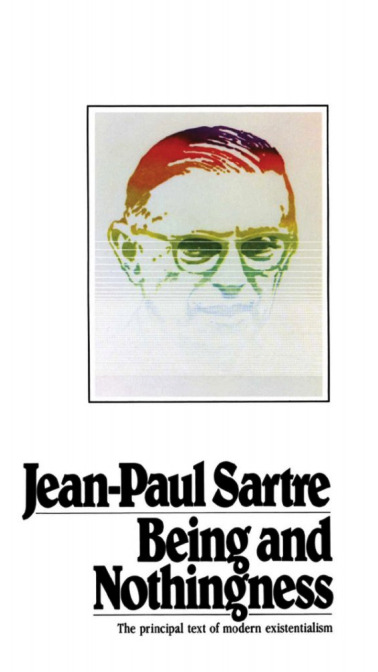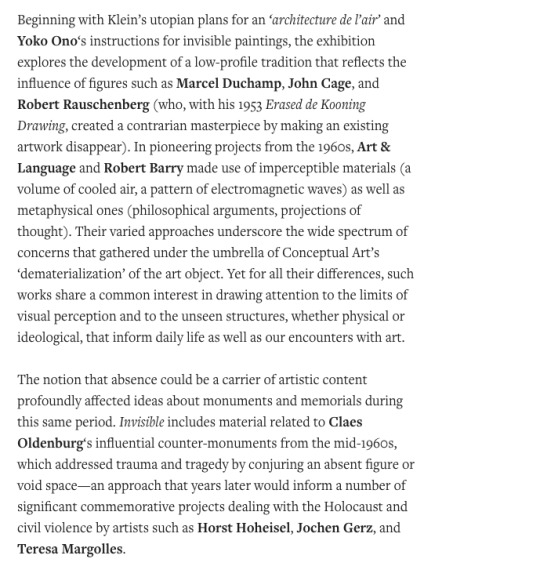Photo


For this new body of work, I have made a series of conversations about materials with architectural space. How people walk through spaces, how they encounter what I make, how it is possible to make work to pause the world a little, is my imperative. At its core is one simple question: it is about what it means to belong in one place at one time.
—Edmund de Waal
0 notes
Photo


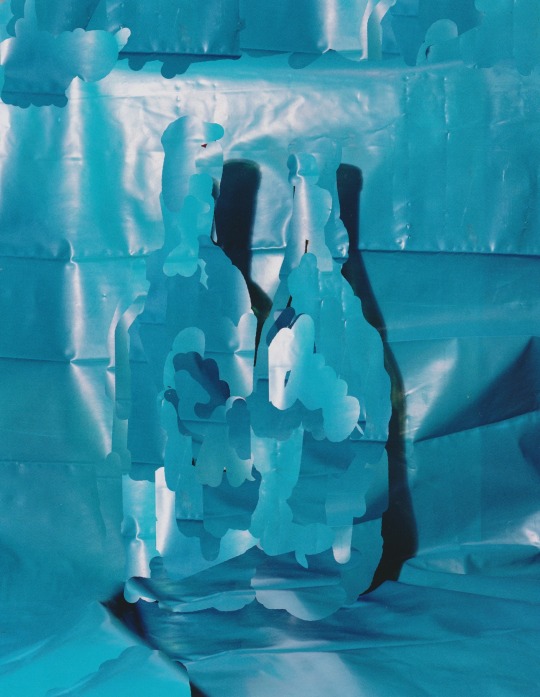




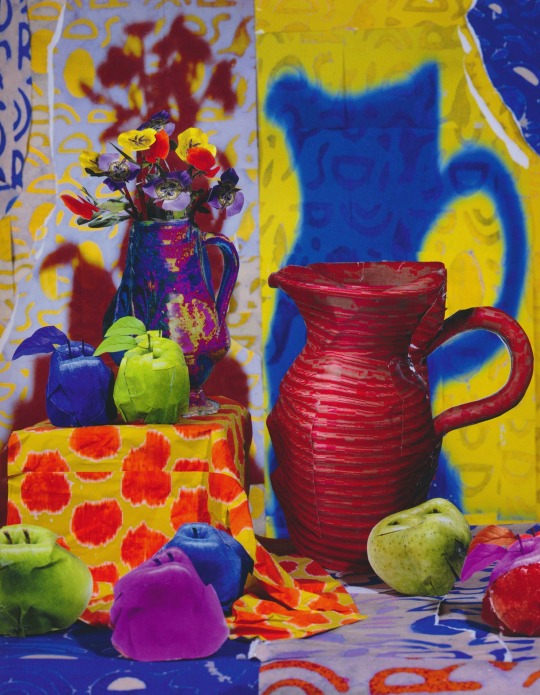
Photography is Magic
Charlotte Cotton, 2015
Notes:
“Magic in both realms is a multisensory experience that calls – instantaneously, and without our consciously knowing it – upon our capacity to script our own sense of visual reality.” p.1
“The connection of magic to contemporary photography is in the idea that magic is something that happens in the viewers imagination. Photographic magic opens us to multiple possible meanings of our visual world, and calls upon our collective ways of looking at it; it also offers us ideas of what that visual world might imply about our contemporary condition.” p.3
“…the photographic provides cerebral experiences for the viewer that are equivalent to magic.” p.3
“Photography Is Magic privileges the potentials of ideas over the virtuosity of individual authors or the perfection of techniques and mechanisms: as with actual close up prestidigitation, ideas are what ultimately allowed the magic to happen.” p.3
“...potent in decidedly new ways, and specifically because of the terms of engagement they proposed: calling upon our ability to construct meaning from our collective muscle memory of making and consuming photographic imagery.” p.3
“…unprecedented compatibility and transparency between viewers and artists…” p.3
“…our ability to comprehend, access, and use photographic tools for capturing, rendering, and disseminating visual ideas.” p.3
“Where we do see citations from photography's past, they're likely premeditated camouflages – misdirections, reanimations – essentially, knowingly made flourishes that create these magical photographic experiences.” p.4
“…the ways in which photographic material reality can be experienced – what it can represent and prompt – are at play in importantly encompassing and expansive ways.” p.4
“…the pervasive automation of photographic rendering has made software the dominant photographic medium.” p.4
“…linking contemporary artistic practise to much older, and deeply human, histories of mark making, envisioning and modelling new paradigms in ways that take into account cultural changes of the moment.” p.5
“…the rapidly evolving context of viewership in which the artists create and operate.” p.5
“This accumulation of new ideas and experiences of the photographic is generated through artistic practises and motivations, creating imaginative possibilities from the contemporary image environment at large.” p.5
“Photoshop brings the practises and lexicon of automation, repetition, and versioning to the fore.” p.5
“…helping to define our image world and questioning it from within.” p.5
“Once software enters the picture... constants become variables.” (Manovich, Software Takes Command, 2013)
“Purposefully destabilised photographic practises are coming into play, and photographic objects no longer necessarily constitute the formal conclusion of artistic inquiries.” p.9
“…destabilised practises and explicitly iterative dynamics to create photographic objects and gestures that are intended to be experienced in this moment of a decidedly flattened – even horizontal – image hierarchy.” p.9
“The systematised ‘rules’ of contemporary image-making have become the terrain that artists are using as a site of play, proving how far they can go in creating contemporary experiences of photographic magic…” p.9
“‘…orchestrated very precisely for the present moment and contingent on activating viewers’ experiences and assumptions of the contemporary visual world.” p.9
“We can now recognise individual artists’ signatures through their repeated navigation and articulation of the dynamic behaviour of photographic culture at large.” p.10
“Today's climate privileges the idea of technology at the centre of a forward-gazing tale of invention and innovation.” p.10
“…revealing just how much our visual antennae have been shifted by the aesthetics of software.” p.11
“…Photoshop as a medium in its own right, with inherent possibilities for creative subjectivity.” p.12
“…photography as a material form.” p.13
“In the context of Photography is Magic, the characterization of the sculpture is as a renderer of objects – exerting control over images as materials and cultural artefacts.” p.13
“The binding together of image and object (or image as object) is a fundamental cultural phenomenon that the artists represented here are consciously designating and navigating. This is a field in which distinctions between original and copy do not dominate and where images act as objects and vice versa, comprehended through their ongoing state of circulation and versioning.” p.13
“This is a manifestation of a profoundly human tendency, which is embedded in the workings of our neural system: each time we call forth a memory, we neurologically and psychologically remake and reposition it, and create new paths of accessibility to that memory or idea out of the new relations that we have conjured.” p.14
“In an important sense, every discreet act of rendering an object or image (whether industrial or artistic) is now a manifestation of the endless circulation of the already made, commodified, and systematised.” p.15
“…interpreting existing viewing behaviours into the dynamic of their practice.” p.16
“Contemporary art photography derives its magical charge from its capacity both to articulate and participate in our collective image environment.” p.18
“The magical possibilities that are created in our imaginations by these artistic gestures may be taken as our entry point into deeper thinking about the image world around us, and may inspire meaningful ideas and dialogues about photography in circulation at this moment. They are ideas on the move, disseminating through visual culture and the states of mind of their viewers. They are prompts for the future of photographic practise, activated by their special form of magic.” p.18
1 note
·
View note
Photo




Edmund De Waal
Phaidon, 2014
Notes:
“…hand-thrown porcelain vessels, clustered in groups on an aluminium shelf or within specially constructed vitrines, or placed inside lead-lined boxes or large-scale architectural settings, to probe the questions that haunt him.” p.11
“He likens throwing to a musician’s practise of scale. You become articulate as an artist only by daily commitment.” p.11
“…convincing case for the humble hand-thrown vessel to be as legitimate a medium for the exploration of complex ideas as any other.” p.11
“One of the most profound explanations of what a pot, a vessel of fired clay, represents as an object in the world was expressed by Philip Lawson in his classic, Ceramics: ‘A pot thus ‘contains’ both the reality of materials and process, and the inner realities of man's sense of identity in relation to his own world of meaning.’” p.11
“When you threw a pot, what you're doing is actually, of course, making an inside and an outside simultaneously, which doesn't happen in very many other places in art. You're making volume in a very short period of time; you're creating an internal space.” p.42
“When you're making a vessel, every single touch of your hand after you've thrown the basic cylinder actually changes the interiority, the sense of internal space completely.” p.43
“…many pots made ostensibly for use actually had more symbolic meanings and that their display was highly charged. Even kitchen cupboards could act as condensed still lives of objects.” p.45
“…he made a virtue of the house’s double life as museum and domestic space. He made work for symbolically domestic spaces while other pieces were used to mark more formal qualities of architecture.” p.45
“His ceramic objects celebrate the domestic and the familiar, while also reflecting broader personal, social and political issues.” p.47
“…a haunting contrast between human vulnerability, even untidiness, of the vessels within and the rigorous machined beauty of the vitrines that hold them. Why have these vessels, these almost-figures, been shuffled so determinedly into line? It is here that the common material of man and vessel – the clay, the dust that forms both – becomes a most pressing metaphor.” p.83
0 notes
Photo
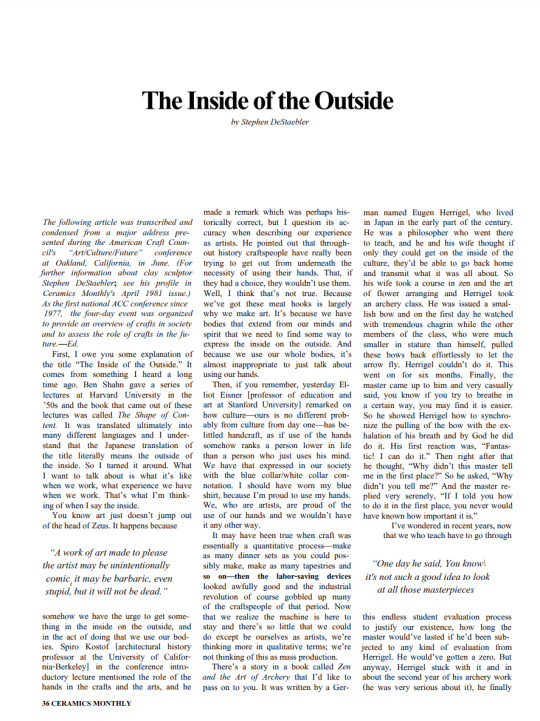
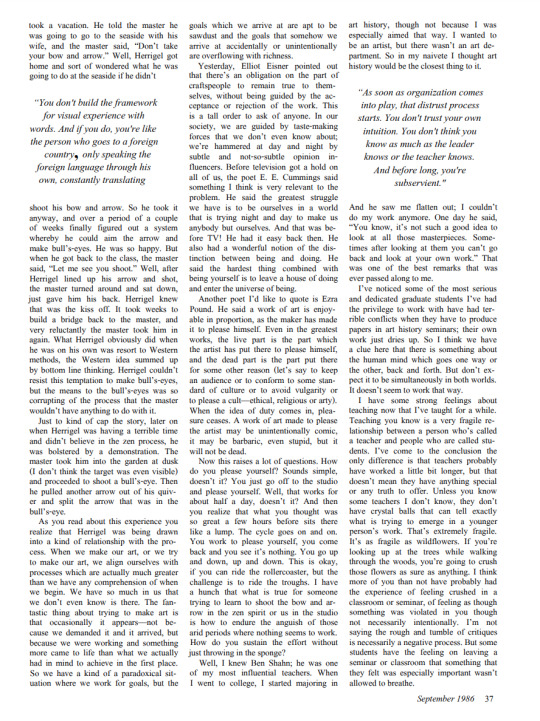
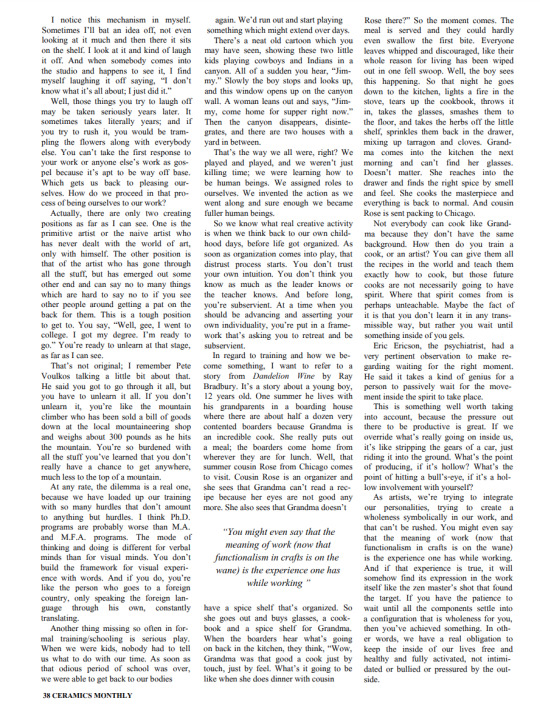
The Inside of the Outside, Stephen DeStaebler
Ceramics Monthly, September 1986
Notes:
“...we have the urge to get something in the inside on the outside, and in doing so we use our bodies.”
“When we make art, or we try to make our art, we align ourselves with processes which are actually much greater than we have any comprehension of when we begin. We have so much in us that we don't even know is there. The fantastic thing about trying to make art is that occasionally appears – not because we demanded it and it arrived, but because we were working and something more came to life than what we actually had in mind to achieve in the first place.”
“You might even say that the meaning of work (now the functionalism in craft is on the wane) is the experience that one has while working. And if that experience is true, it will somehow find its expression in the work itself like the Zen Master’s shot that found the target. If you have the patience to wait until the components settle into a configuration that is wholeness for you, then you've achieved something. In other words, we have a real obligation to keep the inside of our lives free and healthy and fully activated, not intimidated or bullied or pressured by the outside.”
1 note
·
View note
Photo




The Abstract Vessel
John Houston, 1991
Notes
“…artefacts are categorised as fiction and discussed in the context of poetic thought.” p.6
“…in contrast to utilitarian pots, these objects are slowly, thoughtfully built from very personal raw material – the complex imagining of what pottery could be.” p.6
“The function of these pots, is to provide diverse explanations of their own nature.” p.6
“A poeticised culture would be one which would not insist we find the real wall behind the painted one, the real touchstones of truth as opposed to touchstones which are merely cultural artifacts. It would be a culture which, precisely by appreciating that all touchstones are artifacts, would take as its goal the creation of ever more various and multicoloured artifacts.” p.8 (Richard Rorty, Contingency, Irony and Solidarity, Cambridge University Press, 1989)
“…the potter’s wheel encouraging the repetition of hollow forms and so becoming the motivating force behind the fact and the idea of the container.” p.9
“The fiction of social fact exists as an aesthetic which is still tuned to forms and functions that make meaning out of ingenious modulations of the ordinary and the useful.” p.9
“…familiar forms are the shape of domesticated presence; it's protective nature as container as conserver – unites it with the idea and the fact of the house, the home, the prime container. Within that psychological space of the home, such pots can be powerful fictions, furnishing each room with ideas” p.9
“Indeed, the relationship is formed upon the fact that pottery can be described so plainly in terms of natural forces and substances. Clay, rock, water, fire: they continue to keep pottery close to creation myths; even our modern social nature continues to invest the handmade with metaphoric meanings. Pots and other artefacts can represent nature humanised: matter bearing witness to his own transformation by means of 1000 tiny fingerprints.” p.12
“What are these objects? Human activity is a self-defining process: every made thing has meaning, is a representation of the maker’s concern. Objects are made out of human nature, out of our social, hopeful, remembered selves. All artefacts are fictions however much we may hope they can be true or natural or wish that they might exist in some safe and serious dimension, beyond doubt and criticism.” p.17
“If you are going to make pieces expressly to support painting then both body and painting need to interact thematically and metaphorically, so that the contained pot space itself plays a part in the metamorphosis – else the piece just remains a funny object, not an utterance in a language, speech noise rather than poetry.” p.20 (Philip Rawson, Empty Vessels, Ceramic Monthly, 1986)
“…object poised between the ordinary and the metaphorical and exhibiting some ambiguity of purpose.” p.25
“It is only when an object exists in our life for no other purpose and to be seen that we really look at it, as for instance a China ornament or a precious stone, and towards such even the most normal person adopts to some extent the artistic attitude of pure vision extracted from necessity.” p.28 (Roger Fry, An Essay in Aesthetics, 1909)
“Habit and humility have kept the functional pot normal and noble…” p.29
“Industrialization saturated all markets with objects that quickly cornered the cheap and useful market.” p.29
“The vessel is an abstraction that invites metaphor…” p.29
“Vessels are basic, archetypal, timeless. A container is a fundamental prop (and symbol) of civilization. This motive implies its own origins in a kind of collective consciousness, not of forms, but of images and ideas.” p.32
“...something undeniably material, wearing the evidence of its material nature in its visible and tangible forms and attributes, which at the same time contains so much projected into it from daily life and experience at all levels that it can seem to him almost like a projection of his own bodily existence” p.32
“…the vessel has an honoured, ancestral role as a metaphor rich site of fundamental qualities. It is Stonehenge, the Acropolis, Persepolis: each a site of mysterious and semi-mythical presence. In this century the container excites our imaginings at various levels; It is the ideal, the ‘ur-form’…” p.33
“…the vessel remains a central notion – possibly the primary one.” p.33
“Man is a builder of receptacles; a species that does not build any is not human by definition. In short it seems to me that to fabricate a receptacle is due to two qualities which, for good or evil, are exquisitely human. The first is the ability to think about tomorrow, the second is the capacity to foresee the behaviour of matter.” p.33 (Primo Levi, Other People’s Trades, 1985)
“The earliest vessels were shaped by hand from crude clay dug out of the earth, and such vessels were dried in the sun and wind. Even at that stage, before man could write, before he had a literature or even a religion, he had this art, and the vessels then made can still move us by their expressive form. When fire was discovered, and man learned to make his pots hard and durable; and when the wheel was invented, and the potter could add rhythm and uprising movement to his concepts of form, then all the essentials of this most abstract art were present.” p.36
“…solidarity with an image of pottery which is unchanging archetype all and fundamental.” p.37
“Images of change, of feeling transforming substance, of the play of our thoughts transfiguring raw materials; that is the wish fulfilled in these thinking objects.” p.56
0 notes
Text

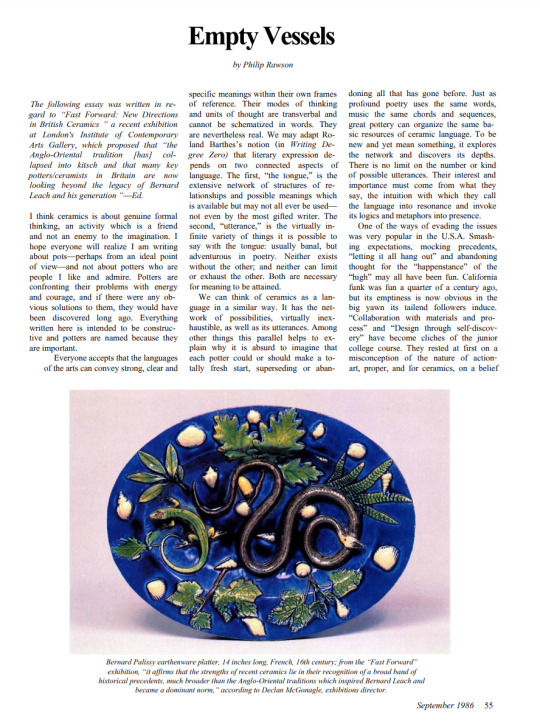


Empty Vessels, Philip Rawson
Ceramics Monthly, September 1986
Notes
“We can think of ceramics as a language in a similar way. It has the network of possibilities, virtually inexhaustible, as well as its utterances.”
“The interest and importance must come from what they say, the intuition with which they call the language into resonance and invoke its logic and metaphors into presence.”
“…ceramic language...”
“If you're going to make pieces expressly to support painting, then both body and painting need to interact thematically and metaphorically so that the contained pot space itself plays a part in the metamorphosis – else the piece just remains a funny object, not an utterance in a language, speech noise rather than poetry.”
“A real three-dimensional form is one which moves in and out, up and down and around, not just as a shape in a neutral space, but in such a fashion as to give a shape to space.”
“…demonstrate shapes movements into the directions of space.”
“…to recreate not one but a sequence of contained volumes within the surfaces of the piece.”
“…no one can make volumes – you can only imply them by means of surface.”
“Maker and viewer need to take an imaginative leap beyond what is actually there to understand what it clearly meant to be intelligible shaped contents, sequences of voids within the piece – centred in the case of a thrown piece. The surface does not vanish but remains at work as a contributor to the meaning.”
“…extraordinary reluctance of many British potters to make compound, articulated shapes.”
“Presence has nothing to do with surfacing, either smooth or rough. It has to do with shaping in relation to human perception. A pot with a presence addresses you through its nearest surfaces – not its most distant at its silhouette.”
“In a sense, it is true that any surface of a fully three-dimensional pot can be turned to offer a silhouette shape. But not all silhouettes give good central presence and imply strong volumes.”
“What matters is the way the pot surface and the volumes which it promotes move positively and generously toward you at its focal place to give a valid sense of being there. So chillingly often we are nowadays given pots that retreat, flattening themselves and huddling back into diagrams.”
“…the conceptual and metaphoric roots of ceramic language…”
0 notes
Text
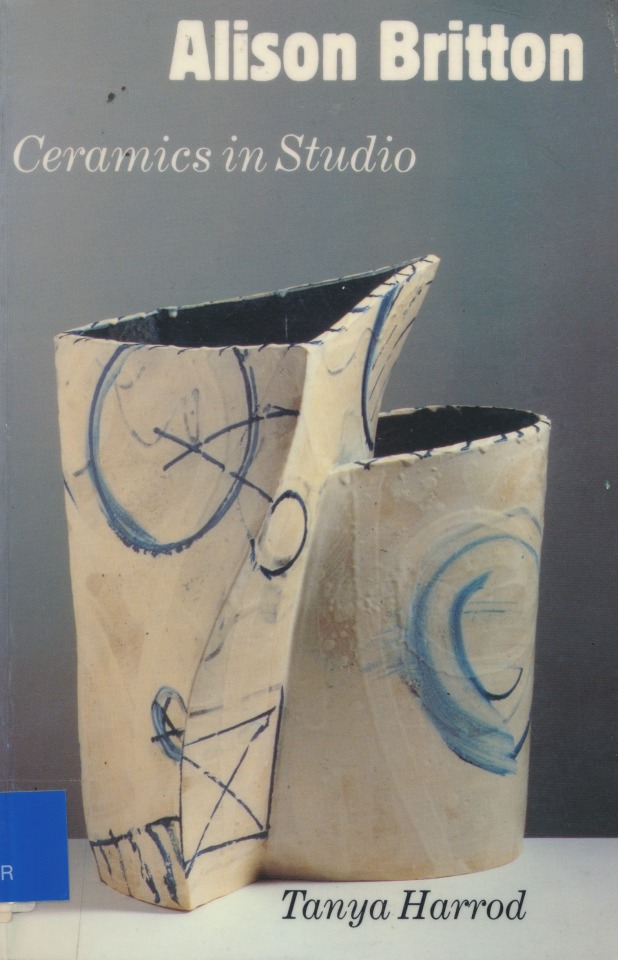


Alison Britton: Ceramics in Studio
Tanya Harrod, 1990
Notes:
“…conducting a series of investigations into a whole range of thoroughly domestic objects: bowls, jugs, boxes, jaws and so on.” p.7
“…the deconstruction of an object was not what was expected of the crafts at the start of the 1980s” p.8
“…inspired by Picasso's ceramics.” p.8
“…playful yet searching look at everyday forms.” p.8
“I woke one morning and saw two jugs on the table; without any mental struggle I saw the edges in relation to each other, and how gaily they almost seemed to ripple now they were freed from this grimly practical business of enclosing an object and keeping it in place.” p.14
(Joanna Field, On Not Being Able To Paint, 1950)
“…she puts together awkward, even unlovely, shapes and then proceeds to transform them with lyrical brushwork and drawing.” p.53
“There is an element of democratisation – sculpture for the home.” p.54
0 notes
Text
Ricky Swallow by David Kordansky Gallery
(David Kordansky Gallery, August, 2013)
Link
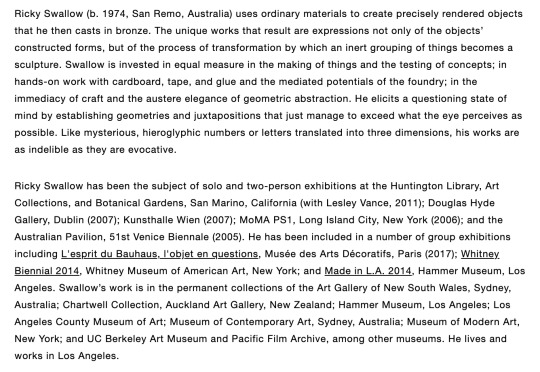

Ricky Swallow, Stair with Contents, 2014

Ricky Swallow, Chair Form with Band, 2014

Ricky Swallow, Double Zero with Rope (doubled), 2016
0 notes
Text
500 words by Ricky Swallow
(Artforum.com, February, 2011)
Link

Notes:
Cast bronze objects created from archery targets the artist found in Los Angeles.
“…synthesise various references from art history.”
“Collecting objects - such as modern ceramics, Native American pottery, baskets and Inuit carvings - and arranging them in different rooms in our home has, for some time, run parallel to my art practice.”
“…wanted to create a sense of vitality, how collecting has affected by studio logic and the forms of the pieces themselves.”
Ken Price “…talking about cups and their universal qualities.
“…how the cup can exist as its own subject matter.”
“…collective ownership and understanding that one brings to such recognisable forms.”
“…intimacy of construction and experience…”
Lucie Rie, Hans Cooper, Giorgio Morandi
“…about translation, passing a subject through various processes on the way to a fixed or permanent sate…”
0 notes
Photo

Anish Kapoor: Making Emptiness
Homi K. Bhahba, 1998
Link to text
Notes:
“The true sign of emptiness.”
“…the presence of an object can render a space more empty than mere vacancy could ever envisage.”
“But the expansion of available space – the making of emptiness – never fails to register a lateral movement, a transitional tremor, that disorders the boundedness of the void.”
“…visual apprehension as contained absence.”
“…expansion of emptiness.”
“…dialectical relationship in which emptiness will travel through the darkening mirror to assume the plenitude of presence.”
“…Kapoor’s sense of making the void more empty…”
“To treat the void as style is to read its emptiness as no more than a plea for the pictorial.”
“…when the 'signals' of figuration or technique are prevented from articulating what they want to mean; when the void's plea to have its vacancy filled is resisted; when the signature of style can no longer name or claim to control the aesthetic logic of the work. Kapoor's voids, standing before us as sculpted objects…”
“The sign of emptiness can neither be fixed as form, nor preserved as an image or an idea.”
“To see the void as a contained negative space indented in the material is only to apprehend its physicality. To figure the depth of the void as providing a perspectival absence within the frame or the genre is to linger too long with the pedagogy of manufacture or the technology of taste.”
“Heidegger 's beautiful parable of the jug for these purposes.11 What does the potter make when he shapes the jug? Of what material is the jug made? The potter forms the sides and bottom of the jug in clay to provide the means for it to stand, to be vertical; to make the jug a holding vessel, however, he has to shape the void.”
“From start to finish, the potter takes hold of the impalpable void and brings it form as the container in the shape of a containing vessel.”
“The vessel’s thingness does not lie at all in the material of which it consists, but in the void that is holds.”
“…in the ‘beholding’ of the jug, there is no simply discernible outside (clay) nor a penetrative inside (void), no easily distinguishable negative and positive spaces.”
“…held together with the sheer, glancing force with which the surface of a sheet of air intersects the line of the sea's horizon, the elements spliced, stapled together in a slanted slash of a white sail that stands the pressures of wind and water, just precariously out of balance – a tense textile, holding the void, withstanding the vessel.”
“…the clay is rooted by gravity to stand, while the void, enlightened by its emptiness, becomes empowered to hold air or water. They come together, in this uncanny relationship, by virtue of the difference that holds them apart; a contest between surfaces, elements or materials or meanings that conjures up one, or the other, through a ‘third’ dimension. This is the dimension of doubling and displacement: the jug is double in the sense that it is no longer a unitary object but as once a relation through clay (material) to void (non-material).”
“Such an articulations through displacement allows us to decipher emptiness as a sign.”
“Kapoor’s void force us to recognise that making art out of emptiness is not a process of the figuration of absence or presence, the image of the empty or the full.”
“The darkness of the void is deceptive, its illusion of space quit elusive.”
“Interiority and exteriority fail to preserve their determining dimensions.”
“…the void as shape, the void as physical presence.”
“…fragile meeting of space and emptiness.”
“…the void mediates our relationship with emptiness.”
“…the difference between the illusion of space and the creating of emptiness.”
“…the void is not silent, I have always thought of it more as transitional space, an in-between space.”
1 note
·
View note
Photo

Nothingness and The Work of Art: A Comparative Approach to Existential Phenomenology and the Ontological Foundation of Aesthetics.
Robert Pinheiro Machado, 2008
Link to text
Notes:
“We do have to allow that at a later moment Heidegger does conceive of a more secure place for human life and art, where concealment, in a way”
0 notes





